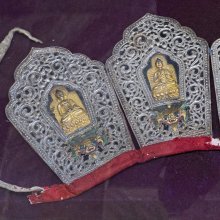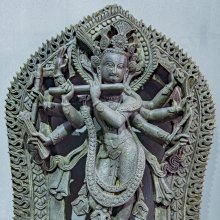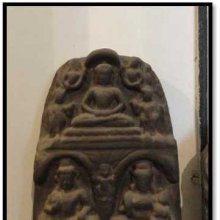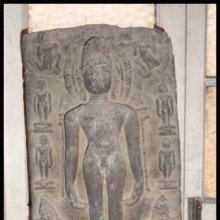Mukuta, Mukuṭa, Mukuṭā: 26 definitions
Introduction:
Mukuta means something in Buddhism, Pali, Hinduism, Sanskrit, Jainism, Prakrit, Marathi, Hindi. If you want to know the exact meaning, history, etymology or English translation of this term then check out the descriptions on this page. Add your comment or reference to a book if you want to contribute to this summary article.
Alternative spellings of this word include Mukut.
Images (photo gallery)
In Hinduism
Purana and Itihasa (epic history)
Source: archive.org: Puranic Encyclopedia1) Mukuṭa (मुकुट).—A Kṣatriya family. It was in this family that the wicked King Vigāhana was born. (Śloka 16, Chapter 74, Udyoga Parva).
2) Mukuṭā (मुकुटा).—A follower of Subrahmaṇya. (Śloka 23, Chapter 46. Śalya Parva).
Source: archive.org: Shiva Purana - English TranslationMukuṭa (मुकुट) refers to a “coronet”, according to the Śivapurāṇa 2.2.25. Accordingly as Rāma narrated to Satī:—“[...] [Śiva] invited Indra and other gods, the Siddhas, Gandharvas, Nāgas, Upadeśas and Āgamas, Brahmā with his sons, the sages and the celestial goddesses and nymphs who came there with various articles. [...] In an auspicious hour, the great lord made Viṣṇu sit on the exquisite throne and delightedly decorated him in every way. A beautiful coronet (mukuṭa) was fixed on Viṣṇu and the auspicious holy thread was tied to his waist. He was then coronated by lord Śiva in the Cosmic Hall”.
Source: Cologne Digital Sanskrit Dictionaries: The Purana Index1a) Mukuṭa (मुकुट).—A tīrtha sacred to Satyavādinī.*
- * Matsya-purāṇa 13. 50.
1b) A hill, west of the Śitoda;1 residence of the Pannagas.2
2) Mukuṭā (मुकुटा).—A river from Ṛṣyavān.*
- * Matsya-purāṇa 114. 26.
Mukuṭa (मुकुट) is a name mentioned in the Mahābhārata (cf. V.72.16) and represents one of the many proper names used for people and places. Note: The Mahābhārata (mentioning Mukuṭa) is a Sanskrit epic poem consisting of 100,000 ślokas (metrical verses) and is over 2000 years old.
Mukuṭā also refers to the name of a Lady mentioned in the Mahābhārata (cf. IX.45.23).

The Purana (पुराण, purāṇas) refers to Sanskrit literature preserving ancient India’s vast cultural history, including historical legends, religious ceremonies, various arts and sciences. The eighteen mahapuranas total over 400,000 shlokas (metrical couplets) and date to at least several centuries BCE.
Natyashastra (theatrics and dramaturgy)
Source: Wisdom Library: Nāṭya-śāstraMukuṭa (मुकुट) refers to a “crown” and is classified as an ornament (ābharaṇa) for the head (śiras) to be worn by males, according to Nāṭyaśāstra chapter 23. It is to be worn on the top of the head. Such ornaments for males should be used in cases of gods and kings.
Ābharaṇa (‘ornaments’, eg., mukuṭa) is a category of alaṃkāra, or “decorations”, which in turn is a category of nepathya, or “costumes and make-up”, the perfection of which forms the main concern of the Āhāryābhinaya, or “extraneous representation”, a critical component for a successful dramatic play.

Natyashastra (नाट्यशास्त्र, nāṭyaśāstra) refers to both the ancient Indian tradition (shastra) of performing arts, (natya—theatrics, drama, dance, music), as well as the name of a Sanskrit work dealing with these subjects. It also teaches the rules for composing Dramatic plays (nataka), construction and performance of Theater, and Poetic works (kavya).
Shaktism (Shakta philosophy)
Source: Google Books: Manthanabhairavatantram1) Mukuṭa (मुकुट) (Cf. Makuṭa) refers to a “crown” (viz., adorned with matted hair and crown), according to the second recension of the Yogakhaṇḍa of the Manthānabhairavatantra, a vast sprawling work that belongs to a corpus of Tantric texts concerned with the worship of the goddess Kubjikā.—Accordingly, as Bhadrakālī said to Śrīkaṇṭha: “[...] (You are) he, the Siddha who has been pierced (by the power of the Command) and, made of universal bliss, is accompanied by Yogeśvarī. He is Śaṃkara’s lord; supreme, he has five faces, three eyes, holds a spear and, adorned with matted hair and crown [i.e., jaṭā-mukuṭa-maṇḍita], (his) divine body is covered with ashes. He is the pervasive lord Ardhanarīśvara”.
2) Mukuṭa (मुकुट) refers to a “diadem”, according to the Kulakaulinīmata verse 3.77-81.—Accordingly, “Tvaritā is without compare and bestows all accomplishments. She is dark blue and her form is that of a (tribal) Śāvarī. She has big, upraised breasts and has two snakes as earrings and two as (her) anklets. [...] She is adorned with a beautiful peacock diadem [i.e., mukuṭa—mukuṭena vicitreṇa māyūreṇa virājate]”.

Shakta (शाक्त, śākta) or Shaktism (śāktism) represents a tradition of Hinduism where the Goddess (Devi) is revered and worshipped. Shakta literature includes a range of scriptures, including various Agamas and Tantras, although its roots may be traced back to the Vedas.
Shaivism (Shaiva philosophy)
Source: Brill: Śaivism and the Tantric Traditions (philosophy)Mukuṭa (मुकुट) refers to a “tiara”, according to Somānanda’s Śivadṛṣṭi verse 3.42cd–47.—Accordingly, “[...] How can there be something pure, something diminished, etc., when his nature is undivided? The fact of being gold simply exists in gold, (be it) in (the form of) a golden spittoon, etc., or in (the form of) a tiara (mukuṭa), etc. The (fact of being) gold is in no way divided [i.e., differentiated] whatsoever. If you argue that a fire installed in an outcaste’s house is not (properly) called a fire [i.e., it is not a proper, ritually-purified fire], we reply: that may be so [i.e., this does not contradict our notion of the uniformity of the nature of fire as such]. [...]”.
Source: Brill: Śaivism and the Tantric TraditionsMukuṭa (मुकुट) refers to “(decorative) crowns”, according to the 13th-century Matsyendrasaṃhitā: a Kubjikā-Tripurā oriented Tantric Yoga text of the Ṣaḍanvayaśāmbhava tradition from South India.—Accordingly, “[Visualisation of Parameśvara]:—[...] He is adorned with nice anklets, armlets, rings and bracelets, and he shines with small toe rings, channahīras, etc., and diadems and a crown (mukuṭa). His face is gracious, beautiful, his lips are smeared with betel leaves. His mind is filled with the joy of wine, and his body is supreme bliss [itself]. [...]”.
Source: SOAS University of London: Protective Rites in the Netra TantraMukuṭa (मुकुट) refers to “crown”, according to the Netratantra of Kṣemarāja: a Śaiva text from the 9th century in which Śiva (Bhairava) teaches Pārvatī topics such as metaphysics, cosmology, and soteriology.—Accordingly, [verse 18.63-68, while describing the iconography of Mṛtyujit and the consort Amṛtalakṣmī]—“After [the Mantrin] has meditated on the beautiful form as indicated earlier, he should worship Mṛtyujit and Śrī Devī [Amṛtalakṣmī], [...]. She is charming [and] wears a pure white crown (suśukla-mukuṭa-upetā). [She has] one face, three eyes, [and is] seated in the baddhapadmāsana, adorned with a Yoga strap, a conch and lotus in [her] hand, the hands [forming the gestures of] wish-granting and protection. Four armed, Mahādevī is marked with all auspicious signs. [...]”.

Shaiva (शैव, śaiva) or Shaivism (śaivism) represents a tradition of Hinduism worshiping Shiva as the supreme being. Closely related to Shaktism, Shaiva literature includes a range of scriptures, including Tantras, while the root of this tradition may be traced back to the ancient Vedas.
General definition (in Hinduism)
Source: Wisdom Library: HinduismMukuṭa (मुकुट)—Sanskrit term corresponding to the english “crown”.
In Buddhism
Mahayana (major branch of Buddhism)
Source: De Gruyter: A Buddhist Ritual Manual on AgricultureMukuṭa (मुकुट) refers to “crown”, according to the Vajratuṇḍasamayakalparāja, an ancient Buddhist ritual manual on agriculture from the 5th-century (or earlier), containing various instructions for the Sangha to provide agriculture-related services to laypeople including rain-making, weather control and crop protection.—Accordingly, “Now the Bhagavān was residing in the abode of Brahmā. [...] [There was] the Garuḍa Lord, the Great King, the one with golden wings, [...]. His head was bound with a crown and a fillet (mukuṭa-paṭṭa). He was decorated with golden ornaments. He had a firmly fixed glance of dreadful character and a seat made by a serpent lord. [...]”.

Mahayana (महायान, mahāyāna) is a major branch of Buddhism focusing on the path of a Bodhisattva (spiritual aspirants/ enlightened beings). Extant literature is vast and primarely composed in the Sanskrit language. There are many sūtras of which some of the earliest are the various Prajñāpāramitā sūtras.
In Jainism
General definition (in Jainism)
Source: The University of Sydney: A study of the Twelve ReflectionsMukuṭa (मुकुट) refers to the “head”, according to the 11th century Jñānārṇava, a treatise on Jain Yoga in roughly 2200 Sanskrit verses composed by Śubhacandra.—Accordingly, “The thirty gods, whose heads are bowed [com.—natamukuṭa], bow down to the line of lotus feet of those whose hearts have become a refuge only for the doctrine. That very same doctrine, which is devoted to the helpless, is a preceptor and a friend, and the doctrine is a master and a brother. It is a protector without a motive”.
Synonyms: Mauli.

Jainism is an Indian religion of Dharma whose doctrine revolves around harmlessness (ahimsa) towards every living being. The two major branches (Digambara and Svetambara) of Jainism stimulate self-control (or, shramana, ‘self-reliance’) and spiritual development through a path of peace for the soul to progess to the ultimate goal.
Languages of India and abroad
Marathi-English dictionary
Source: DDSA: The Molesworth Marathi and English Dictionarymukuṭa (मुकुट).—m (S) A crest, a diadem, a tiara.
Source: DDSA: The Aryabhusan school dictionary, Marathi-Englishmukuṭa (मुकुट).—m A crest, a diadem.
Marathi is an Indo-European language having over 70 million native speakers people in (predominantly) Maharashtra India. Marathi, like many other Indo-Aryan languages, evolved from early forms of Prakrit, which itself is a subset of Sanskrit, one of the most ancient languages of the world.
Sanskrit dictionary
Source: DDSA: The practical Sanskrit-English dictionaryMukuṭa (मुकुट).—
1) A crown, tiara, diadem; मुकुटरत्नमरीचिभिरस्पृशत् (mukuṭaratnamarīcibhiraspṛśat) R.9.13. [मुकुट (mukuṭa) is crescent-shaped, the किरीट (kirīṭa) is pointed and the मौलि (mauli) has three points.]
2) A crest.
3) A peak, point.
Derivable forms: mukuṭam (मुकुटम्).
Source: Cologne Digital Sanskrit Dictionaries: Shabda-Sagara Sanskrit-English DictionaryMukuṭa (मुकुट).—n.
(-ṭaṃ) A crest, a diadem, a tiara. f. (-ṭī) Snapping the fingers. E. maki to adorn, aff. uṭa, and u substituted for the radical vowel, form irr.; also makuṭa .
Source: Cologne Digital Sanskrit Dictionaries: Benfey Sanskrit-English DictionaryMukuṭa (मुकुट).—I. n. A crest, a diadem, [Pañcatantra] 3, 10. Ii. (vb. 2. muc, cf. mucuṭī), f. ṭī, Snapping the fingers.
Source: Cologne Digital Sanskrit Dictionaries: Cappeller Sanskrit-English DictionaryMukuṭa (मुकुट).—[masculine] diadem, crown; p. ṭin.
Source: Cologne Digital Sanskrit Dictionaries: Aufrecht Catalogus CatalogorumMukuṭa (मुकुट) as mentioned in Aufrecht’s Catalogus Catalogorum:—abridged from Rāyamukuṭa Oxf. 182^b.
Source: Cologne Digital Sanskrit Dictionaries: Monier-Williams Sanskrit-English Dictionary1) Mukuṭa (मुकुट):—mn. (ifc. f(ā). ) a tiara, diadem, crown (said to be crescent-shaped; the kirīt, a being pointed, and the mauli having three points), [Inscriptions; Mahābhārata; Kāvya literature] etc.
2) a crest, point, head (See trim)
3) Name of an author (= rāya-m), [Catalogue(s)]
4) Pl. Name of a people, [Mahābhārata]
5) Mukuṭā (मुकुटा):—[from mukuṭa] f. Name of one of the Mātṛs attending on Skanda, [Mahābhārata]
6) Mukuṭa (मुकुट):—n. Name of a Tīrtha, [Catalogue(s)]
Source: Cologne Digital Sanskrit Dictionaries: Yates Sanskrit-English DictionaryMukuṭa (मुकुट):—(ṭaṃ) 1. n. A crest, a diadem. f. (ṭī) Snapping the finger.
Source: DDSA: Paia-sadda-mahannavo; a comprehensive Prakrit Hindi dictionary (S)Mukuṭa (मुकुट) in the Sanskrit language is related to the Prakrit word: Mauḍa.
[Sanskrit to German]
Sanskrit, also spelled संस्कृतम् (saṃskṛtam), is an ancient language of India commonly seen as the grandmother of the Indo-European language family (even English!). Closely allied with Prakrit and Pali, Sanskrit is more exhaustive in both grammar and terms and has the most extensive collection of literature in the world, greatly surpassing its sister-languages Greek and Latin.
Hindi dictionary
Source: DDSA: A practical Hindi-English dictionaryMukuṭa (मुकुट) [Also spelled mukut]:—(nm) a crown; diadem, crest, coronet; ~[dhara/~dhārī] crowned, wearing a crown.
...
Kannada-English dictionary
Source: Alar: Kannada-English corpusMukuṭa (ಮುಕುಟ):—[noun] = ಮುಕುಟೆ [mukute].
--- OR ---
Mukuṭa (ಮುಕುಟ):—[noun] an ornaental headgear, made of precious metals and stones, for the idol of a deity or the one worn by a monarch, king, as a sign of sovereignty; a crown.
--- OR ---
Mukuta (ಮುಕುತ):—
1) [adjective] (correctly ಮುಕ್ತ [mukta]) released (from the bow, as an arrow).
2) [adjective] released from bondages, restrictions, another’s rule, etc.
3) [adjective] released from worldly attachments, sufferings; free from the cycle of birth, death, rebirth; emancipated.
--- OR ---
Mukuta (ಮುಕುತ):—
1) [noun] (correctly ಮುಕ್ತ [mukta]) a man who is freed from bondage, another’s control, authority, obligation.
2) [noun] a man who is not bound by the worldly obligations, relations, attachments, etc.
Kannada is a Dravidian language (as opposed to the Indo-European language family) mainly spoken in the southwestern region of India.
See also (Relevant definitions)
Starts with: Mukutadharin, Mukutakara, Mukutam, Mukutamani, Mukutamanikya, Mukutani, Mukutapatta, Mukutaratna, Mukutaraya, Mukutasamhita, Mukutasthana, Mukutataditaka, Mukutopeta, Mukutotkata, Mukutotpala.
Ends with (+8): Ardhamukuta, Candramukuta, Haramukuta, Jatakamukuta, Jatamukuta, Jvalamukuta, Jvalanmukuta, Karandamukuta, Keshamukuta, Kiritamukuta, Manikyamukuta, Maulimukuta, Mayuramukuta, Natamukuta, Nirmukuta, Pratapamukuta, Pushpadrumakusumitamukuta, Pushpamukuta, Rajamukuta, Ratnamukuta.
Full-text (+59): Makuta, Trimukuta, Mukuteshvara, Maulimukuta, Mukutin, Pratapamukuta, Mukutam, Mukutekarshapana, Mukutataditaka, Mukutaratna, Mukuteshvari, Vajramukuta, Muguta, Mukuda, Mugutamani, Rayamukuta, Haramukutamahatmya, Satyavadini, Candramaulin, Ratnamakuta.
Relevant text
Search found 30 books and stories containing Mukuta, Mukuṭa, Mukuṭā; (plurals include: Mukutas, Mukuṭas, Mukuṭās). You can also click to the full overview containing English textual excerpts. Below are direct links for the most relevant articles:
Garga Samhita (English) (by Danavir Goswami)
Verse 2.7.25 < [Chapter 7 - Kidnapping of the Calves and Cowherd Boys]
Verse 1.4.48 < [Chapter 4 - Description of Questions About the Lord’s Appearance]
Verse 3.7.2 < [Chapter 7 - The Holy Places of Śrī Girirāja]
List of Mahabharata people and places (by Laxman Burdak)
Bhakti-rasamrta-sindhu (by Śrīla Rūpa Gosvāmī)
Verse 2.1.360 < [Part 1 - Ecstatic Excitants (vibhāva)]
Verse 3.3.66 < [Part 3 - Fraternal Devotion (sakhya-rasa)]
Cosmetics, Costumes and Ornaments in Ancient India (by Remadevi. O.)
2.1. Head Ornaments (b): Mukuṭa or Makuṭa < [Chapter 3 - Ornaments]
Sripura (Archaeological Survey) (by Bikash Chandra Pradhan)
Scultures of Manjughosa < [Chapter 3 - Sculptural Programme]
Scultures of Ratnapani < [Chapter 3 - Sculptural Programme]
Scultures of Buddhist Goddesses (3): Vajratara < [Chapter 3 - Sculptural Programme]
Amarakoshodghatana of Kshirasvamin (study) (by A. Yamuna Devi)
Pre-Amarakośa Lexicographers < [Chapter 1 - Kośa Literature–A Brief Survey]
Deviation from convention (Introduction) < [Chapter 6 - Grammatical Aspects]
Related products





